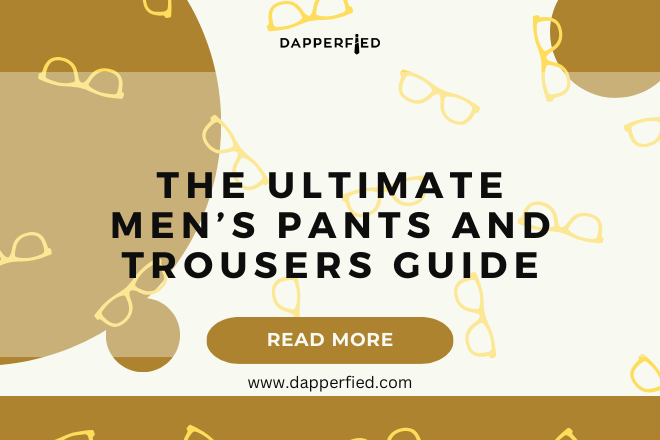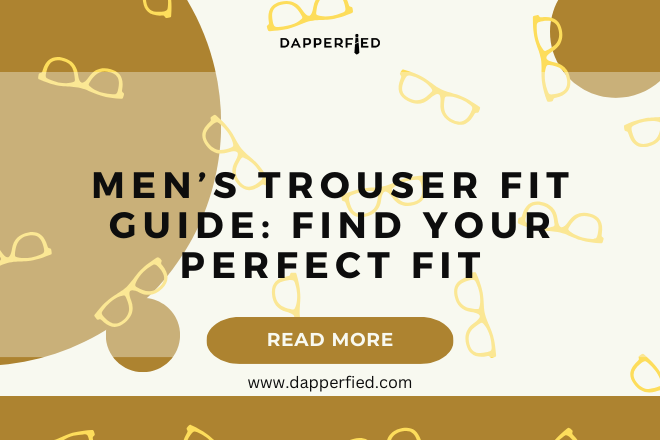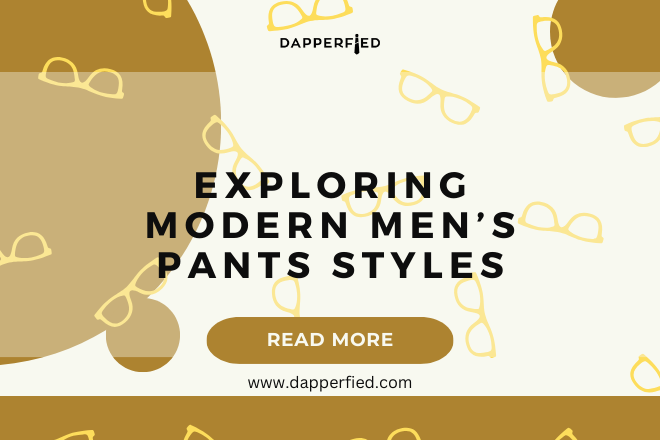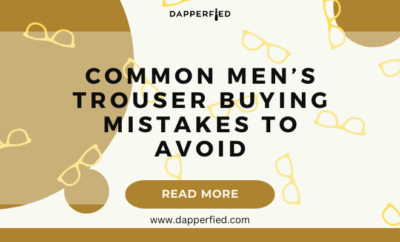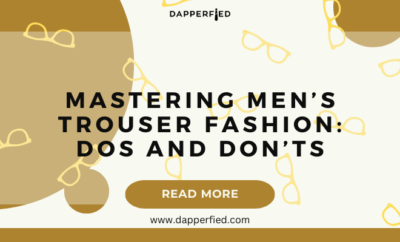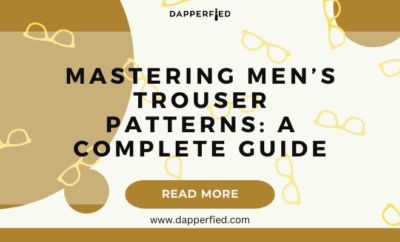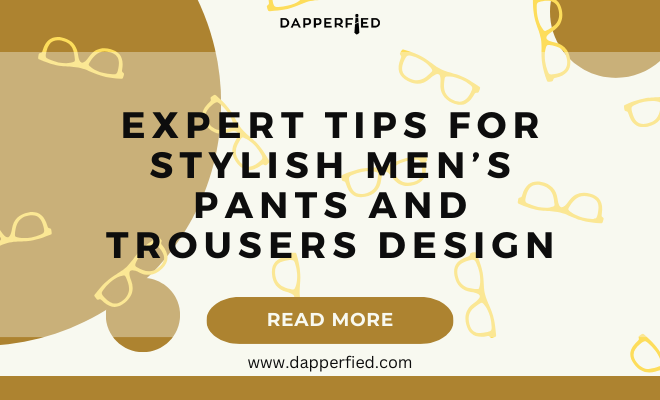
Men's Style
Expert Tips for Stylish Men’s Pants and Trousers Design
When it comes to men’s fashion, there are a wide variety of pants and trousers to choose from, each with its own unique style and purpose. Some of the most popular types include chinos, jeans, dress pants, cargo pants, and sweatpants. Chinos are a versatile option that can be dressed up or down, making them a great choice for both casual and semi-formal occasions. Jeans are a classic wardrobe staple that come in a range of fits and washes, making them suitable for a variety of looks. Dress pants are typically made from more formal fabrics such as wool or cotton and are designed to be worn with dress shirts and blazers for more formal occasions. Cargo pants are known for their multiple pockets and durable fabric, making them a practical choice for outdoor activities. Sweatpants are a comfortable and casual option that are perfect for lounging or exercising.
In addition to the different types of pants, there are also various trouser styles to consider. Some popular options include straight-leg trousers, slim-fit trousers, wide-leg trousers, and pleated trousers. Straight-leg trousers have a consistent width from the thigh to the ankle, creating a classic and timeless look. Slim-fit trousers are more tailored and fitted, providing a modern and sleek silhouette. Wide-leg trousers have a looser fit and are often associated with a more relaxed and casual style. Pleated trousers feature folds of fabric at the waist, creating a more formal and sophisticated appearance. Understanding the different types of men’s pants and trousers is essential for building a versatile and stylish wardrobe that can cater to various occasions and personal preferences.
Key Takeaways
- Understanding the different types of men’s pants and trousers is essential for building a versatile wardrobe.
- Choosing the right fit for your body type can make a significant difference in how your pants and trousers look and feel.
- Pairing pants and trousers with the right shoes can elevate your overall outfit and create a polished look.
- Incorporating patterns and textures into your wardrobe can add visual interest and personality to your outfits.
- Tips for styling pants and trousers for different occasions can help you create appropriate and stylish looks for any event.
Choosing the Right Fit for Your Body Type
When it comes to choosing the right fit for your body type, it’s important to consider your proportions and personal style preferences. For example, if you have a slim build, slim-fit trousers can help create a more tailored and streamlined look. On the other hand, if you have a broader build, straight-leg trousers or wide-leg trousers can provide a more balanced and flattering silhouette. It’s also important to pay attention to the rise of the pants, which refers to the distance between the crotch and the waistband. A higher rise can elongate the legs and provide more coverage, while a lower rise can create a more modern and casual look.
In addition to fit, it’s important to consider the length of the pants. The hem should ideally rest just above the shoe without creating any excess fabric or bunching. This will help create a clean and polished appearance. When it comes to waist size, it’s important to ensure that the pants fit comfortably without being too tight or too loose. Taking accurate measurements and trying on different styles can help determine the best fit for your body type. Ultimately, choosing the right fit for your body type is essential for feeling confident and comfortable in your pants and trousers.
Pairing Pants and Trousers with the Right Shoes
Pairing pants and trousers with the right shoes is essential for creating a cohesive and stylish look. For example, chinos can be paired with loafers or brogues for a smart-casual ensemble, while jeans can be worn with sneakers or boots for a more relaxed vibe. Dress pants are typically worn with dress shoes such as oxfords or derbies for formal occasions, while cargo pants can be paired with hiking boots or sturdy sneakers for outdoor activities. Sweatpants are best paired with athletic shoes or casual sneakers for a comfortable and laid-back look.
In addition to considering the style of shoes, it’s important to pay attention to the color coordination. For example, brown shoes often pair well with earthy tones such as khaki or olive, while black shoes can complement darker shades such as navy or charcoal. It’s also important to consider the formality of the shoes in relation to the occasion. Investing in a few versatile pairs of shoes that can be easily paired with different types of pants and trousers can help create a well-rounded footwear collection that complements your wardrobe.
Incorporating Patterns and Textures into Your Wardrobe
| Patterns and Textures | Benefits |
|---|---|
| Stripes | Creates a slimming effect |
| Polka dots | Adds a playful touch to your outfit |
| Floral prints | Brings a feminine and romantic vibe |
| Knits | Provides warmth and texture |
| Leopard print | Brings a bold and edgy look |
Incorporating patterns and textures into your wardrobe can add visual interest and depth to your outfits. When it comes to pants and trousers, there are various options to consider, such as pinstripes, checks, herringbone, corduroy, and tweed. Pinstripes are a classic pattern that can add a touch of sophistication to dress pants, while checks can provide a more casual and relaxed vibe when worn with chinos or jeans. Herringbone is a distinctive pattern that adds texture and visual appeal to wool trousers, making them suitable for both formal and casual occasions.
Corduroy is a textured fabric that adds warmth and dimension to trousers, making it a great choice for the colder months. Tweed is another textured fabric that is often associated with traditional menswear, providing a rugged and timeless aesthetic. When incorporating patterns and textures into your wardrobe, it’s important to consider balance and cohesion. For example, pairing a patterned trouser with a solid-colored shirt or sweater can help create a harmonious look that doesn’t feel overwhelming. Experimenting with different patterns and textures can help add personality and individuality to your style while maintaining a polished and put-together appearance.
Tips for Styling Pants and Trousers for Different Occasions
Styling pants and trousers for different occasions requires careful consideration of the dress code and overall aesthetic. For formal events such as weddings or business meetings, dress pants in classic colors such as black, navy, or charcoal can be paired with dress shirts, blazers, and dress shoes for a sophisticated look. For semi-formal occasions such as dinner parties or cocktail events, chinos in neutral tones such as beige or light grey can be paired with button-up shirts or knitwear for a polished yet relaxed ensemble.
For casual outings or weekend activities, jeans in various washes and fits can be styled with t-shirts, casual shirts, or sweaters for a laid-back look. Cargo pants are also suitable for outdoor activities such as hiking or camping when paired with performance-oriented tops and sturdy footwear. When it comes to styling sweatpants, opting for tailored or athleisure-inspired options in neutral colors can help create a more elevated and versatile look that can transition from lounging at home to running errands.
Investing in Quality Fabrics and Construction

Investing in quality fabrics and construction is essential for building a durable and timeless wardrobe. When it comes to pants and trousers, opting for natural fibers such as cotton, wool, linen, or denim can ensure breathability, comfort, and longevity. High-quality construction techniques such as reinforced seams, sturdy hardware, and attention to detail in finishing can contribute to the overall durability of the garment.
Additionally, paying attention to fabric weight and seasonality can help ensure that your pants and trousers are suitable for different weather conditions. For example, lightweight cotton chinos are ideal for warmer months, while wool trousers provide insulation during colder seasons. Investing in quality fabrics and construction not only ensures longevity but also contributes to overall comfort and style.
Maintaining and Caring for Your Pants and Trousers
Maintaining and caring for your pants and trousers is essential for preserving their quality and appearance over time. Following care instructions on garment labels such as washing guidelines, drying methods, and ironing recommendations can help prevent damage or shrinkage. It’s important to store pants and trousers properly by hanging them on sturdy hangers or folding them neatly to avoid wrinkles or creases.
Regularly inspecting garments for any signs of wear or damage such as loose threads or pilling can help address issues before they worsen. Additionally, seeking professional dry cleaning services for delicate fabrics or tailored garments can help maintain their integrity. Taking proactive measures to maintain and care for your pants and trousers not only extends their lifespan but also ensures that they continue to look their best with each wear.

In conclusion, understanding different types of men’s pants and trousers is essential for building a versatile wardrobe that caters to various occasions and personal preferences. Choosing the right fit for your body type is crucial for feeling confident and comfortable in your garments. Pairing pants and trousers with the right shoes contributes to creating cohesive and stylish ensembles. Incorporating patterns and textures into your wardrobe adds visual interest and depth to your outfits while maintaining balance and cohesion. Styling pants and trousers for different occasions requires careful consideration of dress codes and overall aesthetics. Investing in quality fabrics and construction ensures durability, comfort, and longevity in your wardrobe. Maintaining and caring for your pants and trousers preserves their quality and appearance over time, allowing you to enjoy them for years to come.
If you’re looking for more style tips for men, be sure to check out this article on young men’s suits for some inspiration on how to dress sharp and sophisticated. Whether you’re looking for a classic suit or something more modern, this article has got you covered. And don’t forget to also take a look at our article on hairstyles for men to complete your polished look.
FAQs
What are some popular men’s pants and trousers designs?
Some popular men’s pants and trousers designs include straight leg, slim fit, bootcut, and relaxed fit. Each design offers a different silhouette and style.
What are some design tips for men’s pants and trousers?
When designing men’s pants and trousers, it’s important to consider the fit, fabric, and details such as pockets, waistband, and closures. Additionally, paying attention to current fashion trends and customer preferences can help in creating successful designs.
How can designers ensure a good fit for men’s pants and trousers?
Designers can ensure a good fit for men’s pants and trousers by taking accurate measurements, using quality patterns, and conducting fittings on different body types. It’s important to consider the rise, inseam, and waist measurements to achieve the desired fit.
What are some popular fabrics for men’s pants and trousers?
Popular fabrics for men’s pants and trousers include cotton, denim, wool, and twill. Each fabric offers different characteristics such as breathability, durability, and drape, which can influence the overall design and functionality of the garment.
What are some key details to consider when designing men’s pants and trousers?
Key details to consider when designing men’s pants and trousers include the placement and style of pockets, the type of waistband (e.g. elastic, drawstring, or belt loops), the closure (e.g. zipper, button, or snap), and any additional embellishments or design elements. These details can greatly impact the overall look and functionality of the garment.

